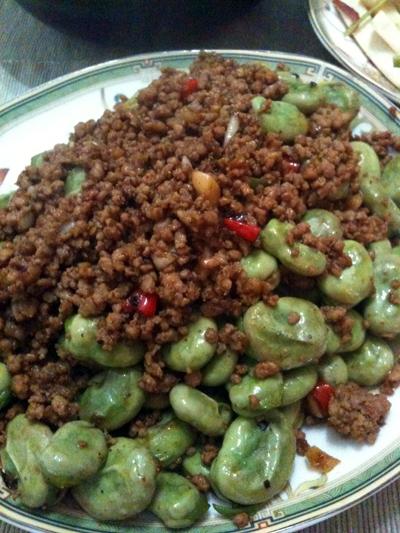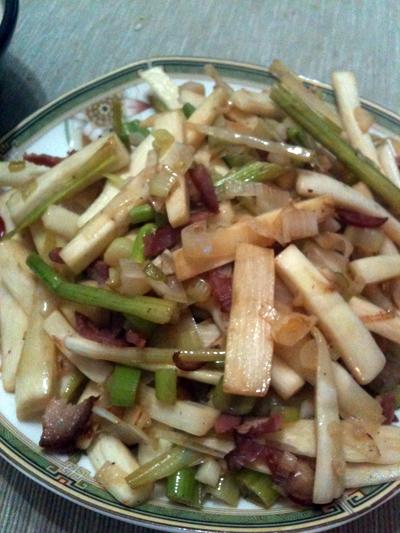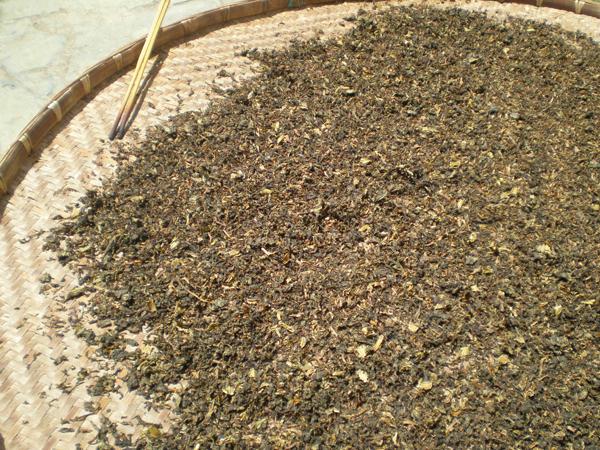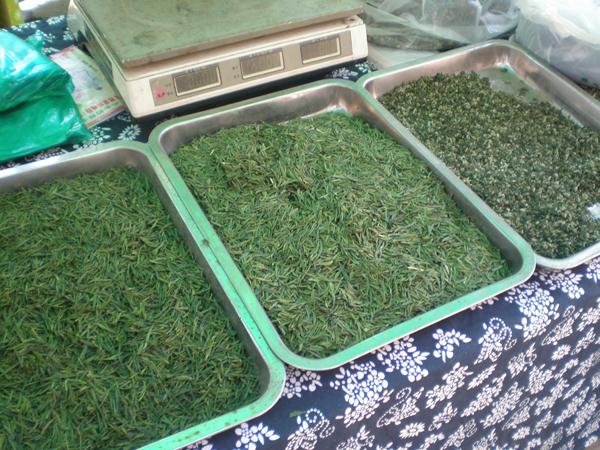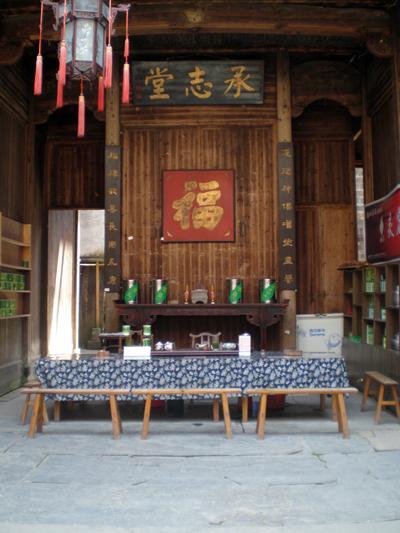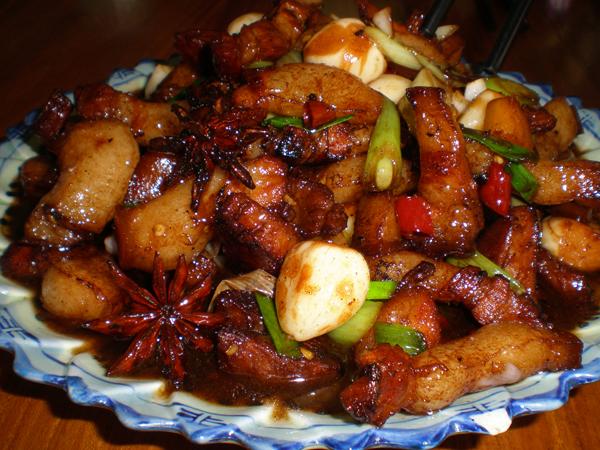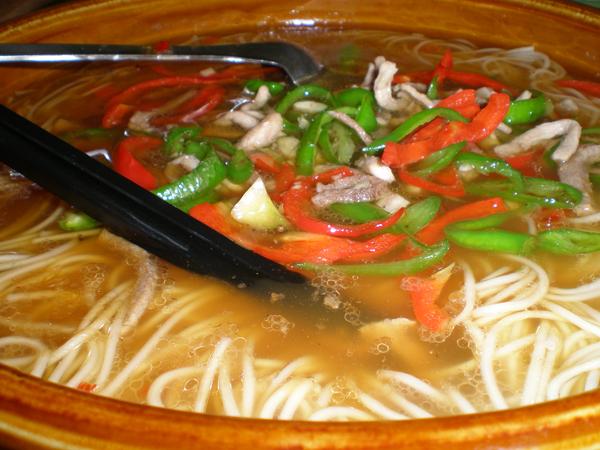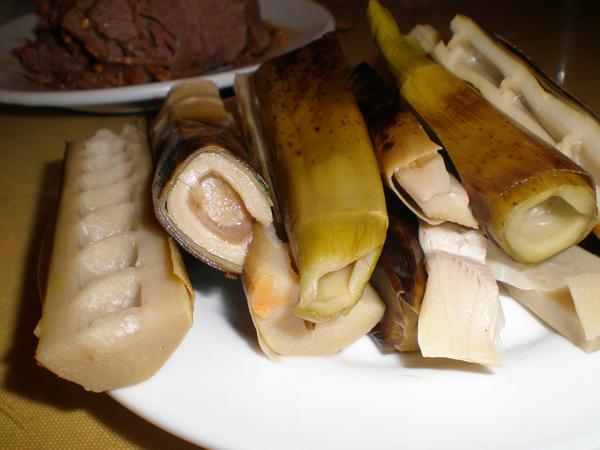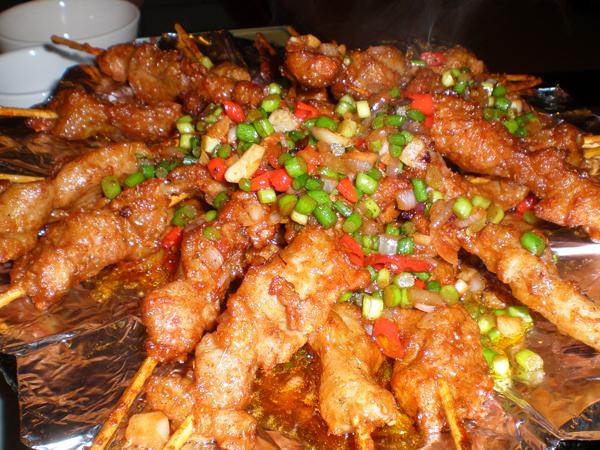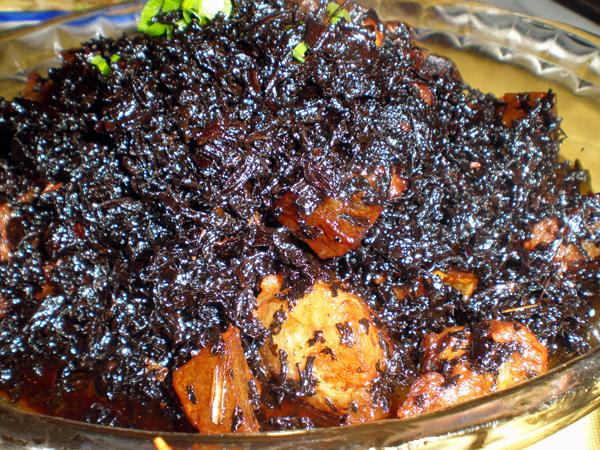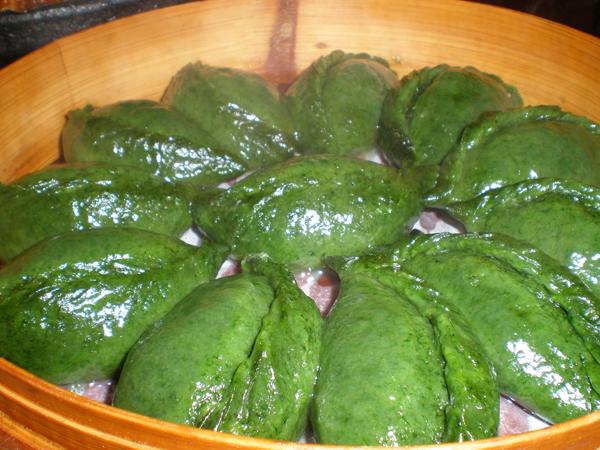-
Posts
3,664 -
Joined
-
Last visited
Content Type
Profiles
Forums
Store
Help Articles
Everything posted by nakji
-

Revolutionary Chinese Cookbook by Fuchsia Dunlop
nakji replied to a topic in China: Cooking & Baking
Fava beans are in season here, so I thought I'd see what Fuschia had to say about them. Turns out she had a great recipe with ground pork. The beans-and-ground-pork meme is strong in Asia. I've had versions of this with french green beans and sugar snap peas in Japan and Korea. They're a natural marriage. This recipe is sparkier than ones I've had before, though because instead of it being a a sweet bean and salty-pork profile, there's also the spice from the chili and the smokiness of the sesame oil to complement it. Very nice - I'm used to painfully squeezing fava beans out of their skins and having them as a bar snack, like I did in Japan (excellent with sake, dipped in sea salt), but Fuschia says nothing about removing the skin from these beans - just removing them from their pods. (Obviously) These beans were so fresh that I did not mind the skins at all. Since bamboo shoots are also in season, I wok-fried some with a little preserved pork as an accompaniment. -
I've made those carrots! They're amazing, aren't they? Try her recipe for cabbage as well - I'm almost sure you've never had cabbage as good as that before. I wanted to buy "Beyond the Great Wall" the other day, and my husband reminded me that I hadn't made much from any of my other books I'd recently acquired during my travels, so it seems like I should make a show of using what I've got. There are some spicy cauliflower pickles from Everyday Harumi, I've been eying, so I brought home a head of cauliflower yesterday to see how that goes. And I'm determined to produce a decent hong shao ruo before I return home to Canada for the summer. I have not had success with the recipe I have in Dunlop's Revolutionary Chinese Cookbook, but everything else I've cooked has come out great, so I suspect user error. I'm going to try again.
-
That afternoon we walked over to Si Xi, a village about 500 m down the road from Yan Cun. This village was much smaller, but had some truly spectacularly carved courtyards. There were also lots of free range chickens hopping about, and some of the mysterious dinner herb drying - I think. Can we confirm this is Mei Cai? Wu Yuan area is also known for its tea, if the information I was seeing off the signs everywhere - along with the hundreds of tea fields that surrounded us - were anything to judge by. I took a chance on a local vendor and bought some bi luo chun-esque tea off him. Actually, most of the village was filled with tea shops and antique stores, but everyone was off on their afternoon nap when we arrived. Here is one of the deserted tea shops in an old courtyard:
-
I'm drinking a very sour bi luo chun from nearby Dong Ting Shan, purchased from my local tea shop San Wan Chang. It's going great with the litchis that have just come into season. I enjoyed Ito En teas very much when I lived in Japan. There's nothing better than a bracing cup of genmaicha first thing in the morning!
-
I think Dorie Greenspan has a recipe in "Baking: From My Home to Yours" in which she uses her brioche dough as the base of sticky buns. I made them for my Dad (a hard-core sticky bun aficionado) when I was home last year - they were decadent, but fabulous.
-
I'm interested in how traditional Korean kimchi pots stack up for anaerobic fermentation against modern methods like...uh, my lock n' lock method.
-
Thanks! Interesting to know about the mei cai - it has such a unique flavour, I really couldn't get over how delicious it was. The second day was our first day of really beautiful weather since about...well, November quite frankly. It was great to see the sun, especially shining on all the villages. We didn't want to spend any more time wandering around Wu Yuan proper, so we skipped a morning noodle/bao search and went right to the villages. (We had some granola bars that I always keep on hand for travel breakfasts.) So, of course, by about 11 am, we were starving when we decided to stop in the village restaurant in Yancun. The staff were surprised by early diners, but seemed game. The restaurant must have been built along with the gate infrastructure by the government, as it clearly wasn't original to the village. Normally these sorts of things are pretty soulless, but the designer had had the sense to build it out of local slate tile, use traditional Chinese furnishings, and then light the whole (cavernous, really) room by cutting out a giant swath of the back wall and turning it into a balcony facing a small mountain and river. Natural lighting! It was a beautiful place for a beautiful meal. We encountered another non-picture menu, so I dredged up by best classroom mandarin to request a pork dish, a vegetable, and a soup; whatever the cooks thought we might like. Thankfully, everywhere I go in China, it seems de rigueur to spend upwards of ten minutes discussing the menu with restaurant staff in detail; here, most of the discussion took place between the restaurant staff; but in the end they suggested qing cai, hongshao rou, and something involving noodles I couldn't catch. We all agreed that their suggestions sounded great - mainly because we actually recognized the dishes in question. Since we were so early, they had to send someone off to find the chef, so we had lots of time to admire the view. We got cups of local green tea, and one of the ubiquitous pink thermoses that no indoor space in China is complete without to refill our cups. When the food came, we couldn't believe our luck. Perfectly cooked - I can never get my hong shao rou this good at home. How can workers in a government cafeteria achieve such excellence? Because they have been cooking it forever? I am humbled. Noodle soup - there was so much of it, I felt like we pulled bowls of it one after another without ever making a dent. The qing cai was also perfectly fresh and with the perfect amount of wok hei. The vegetables came from the village gardens, which explains their freshness. Countryside cooking at its best! Our view of the village:
-
Huh. So salt on meat directly draws out liquid, but salt in liquid on meat helps the meat draw in water - oh, this is reminding me of a Grade Eight science class. Is a marinade similar to a brine then?
-
Well, certainly, you can get an egg sandwich the world around, and other places have their own ideas about what makes a good one. It seems that generally, for those egg sandwiches that are made to order, whether it be New York, Vietnam or Korea, a fully cooked yolk is desireable, either for portability or food safety reasons. Although, once, at a McDonalds in Japan, I had an egg sandwich for breakfast that had a fried egg, runny yolk, with mayo on bagel. It was awesome, even though I got yolk all over my face and arm. How many people, when preparing one at home, prefer a runny yolk - when you can eat it over the sink to catch any runs or drips, or when you have other cleaning infrastructure in place?
-
That's not nearly shameful enough. Throw some mayonnaise in there, make the sausage SPAM, make the crackers saltines, and then we might get judgemental. Actually...that sounds kind of delicious now that I think about it.... Right now I would kill for a Dunkin' Donut. My shame for today will have to be eating cottage cheese for breakfast directly out of the container because I didn't want to dirty a bowl. The great thing about a donut-based diet is the lack of necessity for dishes.
-
I was putting together a simple marinade for pork skewers for the first grill of the season (w00t!) last night: lemon juice, olive oil, rosemary, pepper and....I was reaching for the salt and then got paralysed - should I be putting salt into a marinade? I was intending to keep the meat in the marinade for about three hours. Should I have been worried about salt leaching moisture out of the meat? The meat in question was pork loin.
-
Well, I agree with this, and certainly my collection of kitchen equipment is evidence that I own lots of nothing - one downside of moving frequently for the food is that while you do get to sample a wide range or regional food, you do sacrifice a little in the way of things like permanent vegetable gardens, expensive unitasker equipment like ice cream makers and similar. I've had to compromise on the sorts of foods and cuisines I could explore, too, as where I live comes without Western necessities like ovens. So I've had to shelve my ambitions to explore sourdough breads, and I only look at books like The Perfect Scoop and sigh.
-
This past Labour Day (May 1st), I had a four day holiday and took a road trip with some friends to Wu Yuan, an area somewhere in Northeastern Jiangxi, bordering on Anhui province. Wu Yuan is a charming collection of some very old villages, cobbled together and managed as a tourism district by the local party authorities. It's quite popular with domestic tourists, but seems to be relatively unknown to foreign tourists. I'm not sure why - they are beautiful - the houses date from the Eighth century, but are still working villages, with people planting rice and still living a relatively rural lifestyle - no doubt heavily subsidized by the government. For a cool 160 kuai, we bought a three day pass to have unlimited visits to the villages, drive around rice paddies, canola fields, and tea plantations, and generally take in the clean air of the countryside, fresh tea, and killer dried pork products. It's now tea season, which happily coincides with young bamboo season - 笋 We ate a lot of both. We encountered heavy construction on our first night in the area, and so were late getting into town. Although our guidebooks recommended staying in the actual villages surrounding Wu Yuan, it was dark by the time we got there, and we weren't sure of the condition of the road. We elected to stay in Wu Yuan proper, which I can say with confidence you can give a miss on your next trip - unless you're a tea trader. No matter the town, however, you're never far away from a good meal in China, though, so we stopped at a restaurant next to our guesthouse (the rooms of which performed the unusual trick of looking better in the light of day than they did in the dim evening light) which had set some tables out along the sidewalk to better take advantage of the warm evening. The beer was as warm as the evening, but the dishes were nice. We were at a bit of a disadvantage as our conversational Chinese is better than our ability to read menus, so we simply asked for the house specialties, which didn't disappoint. We started with cold beef and boiled bamboo shoots, which I thought reminded me of eating artichokes. Then, we had some lamb skewers with cumin, dressed with chili and green onions. Waaay too many for the three of us. Especially considering we'd also ordered: Pork belly in mystery herb. Anyone know what this black herb is? I feel strongly that it was tea that had been dried and then deep fried, but language skills escaped me. It was really complex and earthy, and unlike anything else I'd tasted before. Marvelous. We'd also ordered the house specialty - dumplings made with rice and chrysanthemum-leaf wrappers, and stuffed with garlic chives, mushrooms, and smoked tofu. Wow. Wow. I was the only one who liked them, though. I blame them and the warm beer I ate for falling into my dubious bed at 9:30 and sleeping through the fireworks display. So...anyone know what that pork dish was? I have a good idea how to recreate it, but only once I verify what the herb was.
-
Almost all the pickles I make are quick pickles meant to be consumed within the week. Thus, I usually use just a sealable glass jar - I have several from Muji which work. When I make kimchi I always use Lock n' Lock, sonce they seem to have the, uh, lock on keeping kimchi odor contained.
-
Shocking news, this. But since getting used to each of her recipes starting with 1/3 cup of olive oil in "Italian Kitchen", I just add that to the pan now as a default. Nevertheless, it sounds like seeking out the original is worth it. Another great suggestion! I bought this in February with the intention of cooking through it, but have given up the project, as I can't get most of the ingredients - but if I could, I would definitely be working my way through it.
-
I've seen this book at my local bookshop, and I've thought about buying it, but it almost seems like more of a coffee table book than a cookbook. It's good to hear that recipes work and are good. I might give it a second look.
-
I'm not a fan of brown rice...it just feels too heavy for me. It's highly probable I've never cooked it correctly, but I'm not that keen to mess around trying to make it better; I prefer to make a multi-grain blend of rice with millet and purple rice.
-
Helen, I bought Everyday Harumi in February and am only just now getting around to opening it up. You gave it to your nephews, but have you tried anything out of it yourself?
-
When I make them at home, (which is rare) I use toasted whatever-bread's-on-hand, an omelet, and maybe ham if it's around. English muffins and pre-sliced cheese are decadent luxuries. And I'm not dexterous enough in the mornings to slice my own cheese. But really, I think these are the sort of thing that I enjoy most when someone else has made them. In Korea, street cart vendors sell "toast", which is two slices of white bread griddled in margarine before you, then a thin omelet made with egg and a mirepoix of Korean vegetables - usually carrots and something green - leek? Who knows. Sometimes they add sugar. This is an abomination, I know, but you kind of get used to it. They assemble the egg and bread with some deft flips of their griddle paddles, then offer ketchup, mayo, and shredded cabbage as garnishes. I always demur. The key to enjoying these is not having them for breakfast, but having them when you're staggering home after a night in the pub. The best pre-made egg sandwiches I've enjoyed were made by the ladies that prowl Hanoi in the morning with their frypans, braziers, and eggs hung off their shoulders in baskets. They even have a ministool in there for you to sit on while they cook. They favour omelets, too, but beat in fresh Hanoi herbs into the eggs. Their eggs get folded into a crispy Vietnamese baguette, and the challenge is to eat it without the shards of the baguette shredding your upper palate, but before the bread gets soggy from egg steam.
-
Oh, wow. You can have your own tandoor parties! I'm so jealous. The coals you're using are the same style ones used in barbecue restaurants in Korea for meat grilling. I'm surprised that a European company makes them as well, as I'd despaired of finding them outside of Korea. They keep the heat fairly well, don't they? Are you going to try more complex naans, like stuffed kashmiri naan or similar?
-
I usually make it just as she says, but then I serve the whole recipe to two people. It seems a little small, but I think it's meant to be served in the Japanese manner, accompanying an array of other dishes. If I make it for more than two, I just double the recipe. Warning: it is incredibly delicious, and there are virtually never any leftovers. When I make it, I serve it alongside other dishes such as Harumi's tofu steak, a pickled vegetable salad, and some rice. As to the cucumbers: first, if you can use anything other than your standard North American supermarket cucumber, do. Ideally you could get your hands on some small pickling cukes, or similar. What you want are the thin, long, green ones with a rough dark green skin. If you've got an Asian market in your neighborhood and feel like a trip, check out what they have. Otherwise, English cucumbers will do in a pinch, but they tend to be quite watery. Then, you don't peel them. Rather, you use some salt as an abrasive exfoliant - rub the salt roughly along the skin, so it scrapes it lightly in some places. You should smell a kind of "green" smell coming off the cucumbers, especially if they're fresh. This process is meant to take the bitterness out of the flesh. Then you rinse the salt off, and cut them as per the recipe. But if you're stuck with a standard cucumber, I would peel and core it as usual.
-
According to the preface of my copy of Essentials, it's made up of The Classic Italian Cookbook and its sequel. Is there any reason to recommend the original "Classic" over "Essentials"- other than the fact it's no doubt shorter?
-
Of course, everybody knows about squeezing in a wedge of lemon or lime into a coke to add polish to your soda. And we've all heard the urban myth about dissolving a nail/fly/rational skepticism in Coke overnight. But one of my favourite tea shops takes it to a new level - they make a hot drink by adding a knob of fresh, peeled ginger slices into a mug of coke, boil the whole thing up with the espresso steam wand, and serve it as a restorative tonic. It sounds appalling at first, but my husband ordered it after another friend had one - and is now hooked. It's kind of strange without the characteristic nose-tickling bubble of the carbonation lost through the steaming process, but it's not without merit. There are, of course recipes for coke-on-a-ham and diet coke cake, but I'm interested in keeping the coke as a beverage - what else can you do to it to liven it up?
-

Products and tools for organization of fridge and freezer
nakji replied to a topic in Kitchen Consumer
You got a picture of that fridge? What kind of dimensions are we working with? -
Fusion! Well, consider what Pizza Hut does to pizza in Japan to make it more palatable to the local population, then why not twist sushi around? Not sure I'd really want to try it though, although that's more my opinion of Hamachi House than the concept of sushi pizza itself talking.


